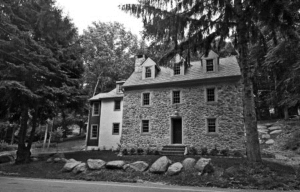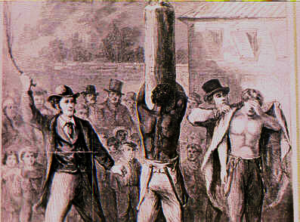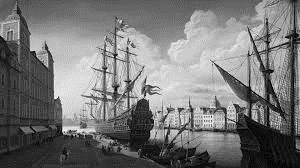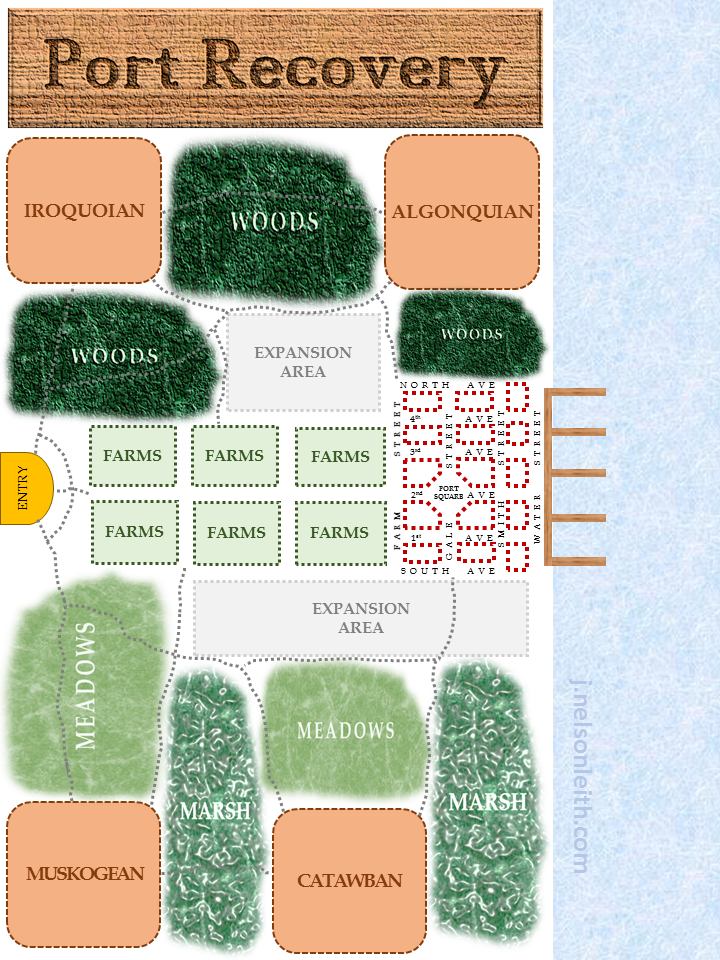 There are many groups dedicated to maintaining East Coast North American crafts from the 17th, 18th, and early 19th centuries, including military reenactors, maritime/pirate enthusiasts, Native American traditionalists, and tradesmen of various skills. There are also many historical structures in danger of being lost to developments or disuse.
There are many groups dedicated to maintaining East Coast North American crafts from the 17th, 18th, and early 19th centuries, including military reenactors, maritime/pirate enthusiasts, Native American traditionalists, and tradesmen of various skills. There are also many historical structures in danger of being lost to developments or disuse.
I have an idea that could serve these reenactment communities and save the historical structures: an historical park set somewhere on the outer shore of the Delmarva peninsula at a place accessible by tallships. Some of the buildings could be built on-site using traditional means, but there would also be a concerted effort to relocate threatened historic structures from all along the East Coast and renovate them. Essentially, it would be constructing an archaic city where traditionalists could practice their crafts, network with other enthusiasts, sell their wares to tourists, and educate visitors. It would also be a place where academics could share their expertise in preservation and history.
The cut-off in the mid-19th century would be in deference to the many other venues for Civil War history. The focus of this park would be the history of the East Coast of North America up to the events precipitating the Civil War. In honor of the park’s purpose, and playing on the names of two forts of the period (one in Ohio and one in the Virgin Islands), I would call it Port Recovery.
THE FUNDING ISSUE
 Obviously, the relocation and renovation of threatened structures would make up the largest part of the budget, and would likely rely heavily on historic preservation grants. This would include whole buildings as well as bridges, walls, gates, milestones, and other threatened structures.
Obviously, the relocation and renovation of threatened structures would make up the largest part of the budget, and would likely rely heavily on historic preservation grants. This would include whole buildings as well as bridges, walls, gates, milestones, and other threatened structures.
Another vector of funds would be educational grants and charitable donations. Key would be maintaining the academic integrity of the site, with some occasional indulgences in pure fancy for promotional and profit purposes—for example, a Pirates & Mermaids Week that would entertain more fantastical traditions. Perhaps the serious pirate and naval reenactors would have to be given their own special event, or maybe half of a shared Maritime Week.
However, the core focus of the site would be on preserving and presenting history for the general public, while providing reenactors and academics an opportunity to networks and share information.
The structure of the park would include a central urban area for city-style buildings along the water, surrounded by small farms, Native American villages, and wilderness zones characterized by meadows, woodlands, and marshes. The exact location of the park is open, but preferably somewhere on the outer Delmarva Peninsula, perhaps Burtons Bay, Hog Island Bay, Magothy Bay, or Sinepuxent Bay just south of Ocean City.
Of course, there are viable locations elsewhere, from Georgia to New England, which would also be appropriate. Pamlico Sound is particularly promising, but it would be important to keep the park central along the East Coast to minimize the costs of relocating threatened historic structures along the East Coast from Maine to Florida.
What would be the four key sections of the park?
First, the urban port to house the park’s central management, employee housing, and visitor venues, with museums to display relics and port facilities to receive historic tallships. Here, urban-style historical structures would be relocated and renovated as inns, restaurants, shops, and museums. There would, of course, also be structures built using traditional techniques to fill out the neighborhoods and provide practice for crafters. Plaques by the doors of each building would identify the provenance of each site.
Second, the reconstructed Native American villages to represent the peoples of the New World present when Europeans arrived, to practice crafts and educate visitors on native traditions. There would need to be features dedicated to the Algonquian, Iroquois, Catawban, and Muskogean cultures to various peoples all along the East Coast were represented. Reenactors could immerse themselves in traditional lifeways and visitors could observe and experience traditional skills, products, and foods. Particular attention would be made to preserving and presenting the Native American linguistic terms for the cultural artifacts being represented.
Third, the surrounding areas for relocated rural structures, to display for visitors and to practice the crafts of colonial farming traditions. This would include imported European models and adopted Native American models of agriculture. There would also be a focus on heritage breeds of farm animals and traditional modes of raising, processing, and cooking foodstuffs. This would have to include the entire spectrum from the highly organized plantation model of the South to the more individualistic farmhold model of New England.
Fourth, the wilderness areas where reenactors in the Native American and European backwoodsman traditions could interact/network and educate visitors on the history of interracial relations. This would include survival skills, the cultural context of interracial trade, and the history of various frontier wars. Primitive cuisine, campsite techniques, and wilderness dress would be exchanged among enthusiasts and academics, and would be presented in an educational capacity to visitors.
SCOPE OF PRESENTATIONS
But, speaking of interracial relations, there would be other important features—spread throughout the key sections—to address the slave trade of African peoples and indentured servitude of Gaelic and lower-class peoples.
 For example, in the urban and rural areas would be venues exploring the experience of African-American slaves in the New World. Port Recovery would offer to relocate artifacts of slavery that local communities wanted to rid themselves of for political reasons—troubling whipping posts and auction blocks—in order to educate visitors on the atrocities of slavery. Servant residences and other artifacts, like documents of indenture and slavery, would be preserved and exhibited. Reenactors would be employed to humanize and contextualize the lives of enslaved and indentured persons.
For example, in the urban and rural areas would be venues exploring the experience of African-American slaves in the New World. Port Recovery would offer to relocate artifacts of slavery that local communities wanted to rid themselves of for political reasons—troubling whipping posts and auction blocks—in order to educate visitors on the atrocities of slavery. Servant residences and other artifacts, like documents of indenture and slavery, would be preserved and exhibited. Reenactors would be employed to humanize and contextualize the lives of enslaved and indentured persons.
An important part of this would be to have specific exhibits on African-Americans in colonial maritime history, as well as information on the presence of Muslim Africans among the enslaved. Likewise, significant attention would be given to other minority spiritual communities during the period, including Jews, Catholics, Quakers, Puritans, and Native Americans.
Other important features would be specific venues to practice and present the differing roles of men and women in the period. Military, hunting, and political exhibits presenting traditional masculine obligations would be offset by home-building, cooking, and familial exhibits presenting traditional feminine obligations. The aim would be to educate visitors in the differing, traditional gender roles that men and women experienced in the period.
SUMMARY
The overall goals of such an historical park would be: to preserve threatened historic structures; to create an opportunity for various academic and traditional craft communities to exchange ideas and skills; and to engage and educate the public on the history of the 17th, 18th, and early 19th centuries.
Imagine taverns where archaic cuisine and drinks (like flip and orange fool) were available to visitors. Imagine shops where history books and recreated artifacts were available for purchase by enthusiasts. Imagine events where traditional military skills were on display, where visitors could tour tallships and other historical structures, where Native American cultures were exhibited, where the lives of enslaved and indentured persons were presented, where the experiences of women and men were shown in their privileges and obligations, and where history is lived via actual structures and artifacts from the period.
This is my vision of Port Recovery.


